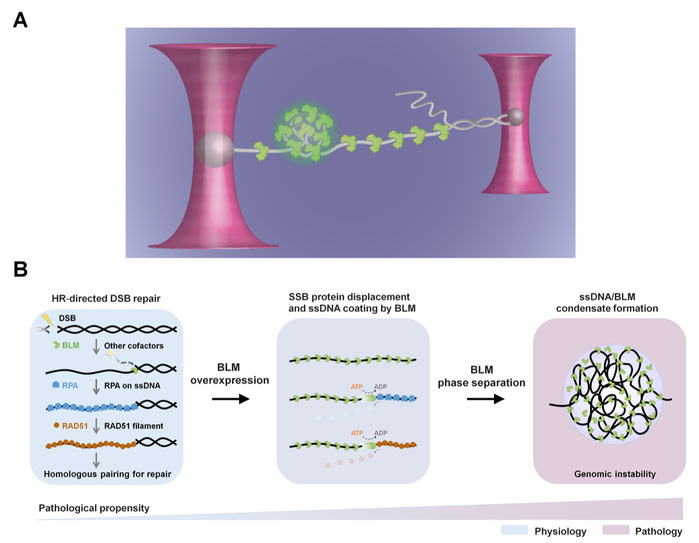Recently, the research team led by SLST Associate Professor Sun Bo, in collaboration with the team led by Professor Liu Cong from the Interdisciplinary Research Center on Biology and Chemistry, CAS, have jointly published a research result in Angewandte Chemie International Edition, which reveals a novel interaction model between bloom syndrome helicase (BLM) and single-stranded DNA (ssDNA). The article is entitled “Bloom syndrome helicase compresses single-stranded DNA into phase-separated condensates”.
Over the past ten years, protein phase separation has been reported in many biological processes, in which nucleic acids are found to be widely involved in regulating protein phase separation and condensation dynamics. For example, dead-box RNA helicases, through phase separation, play critical roles in many aspects of RNA metabolism. However, phase separation studies on DNA helicase is still minimal. It remains challenging to directly visualize and characterize the interplay between nucleic acids and protein under a phase-separated state.
BLM, as one of the critical RecQ family helicases, is involved in many aspects of genome stability maintenance. The overexpression of BLM found in multiple cancer tissues, such as breast cancer and lymphoma, is believed to be closely related to genomic instability. However, the molecular mechanism underlying the genome instability and increased cancer incidence associated with BLM overexpression remains largely unknown.
In this research, by using fluorescent optical tweezers, the researchers found that BLM under high concentration can compress newly-generated ssDNA and form co-condensates after double-stranded DNA (dsDNA) unwinding (Figure A). With the introduction of ATP, the capability of BLM to condense on ssDNA is potentiated, which further promotes the compression of ssDNA against a resistive force of up to 60 piconewtons. Moreover, the researchers provided direct evidence that BLM can compress ssDNA by first dismantling ssDNA-bound RPA or RAD51 proteins (Figure B).They further demonstrate that ssDNA co-phase separates with BLM and promotes the formation of dynamically arrested co-condensates of ssDNA and BLM with apparent decreasing reversibility.

(A) BLM helicase compresses ssDNA generated from dsDNA unwinding. (B) Model of the genomic instability caused by overexpressed BLM interfering with homologous recombination via ssDNA compression and co-condensation.
These findings identify an unexpected characteristic of a DNA helicase and provide a new angle of protein/ssDNA co-condensation for understanding the genomic instability caused by BLM overexpression under diseased conditions.

